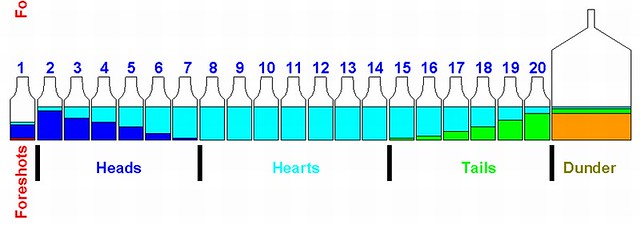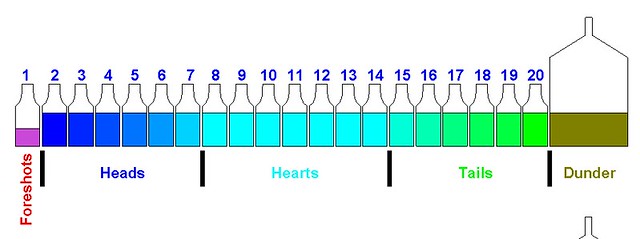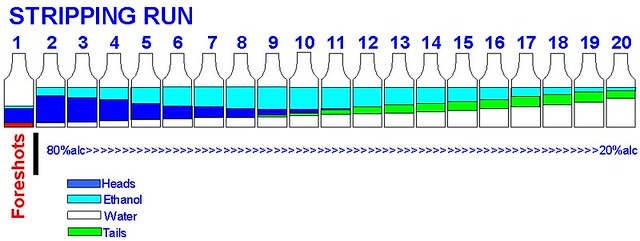The Lazy Stiller's Novice Guide to Cuts and Fractions (pot still)
This guide is aimed at educating a pot still novice about the different fractions in a distillation, and to help them learn how to make cuts between them.
1 - What are cuts and fractions?
2 - An outline of fractions
3 - Fractions illustrated
4 - Cuts and blending the easy way
5 - What about double and triple distillations?
6 - What to do with feints?
1 - What are cuts and fractions?
Cuts are the points in a distillation run where the stiller separates the distillate into separate fractions (divisions between sections of the run). In order to make good cuts, it is important to understand what the different fractions of a run are, and how to recognise them.
2 - An outline of fractions
Once you know your equipment and your mash, fractions are fairly predictable. The ABV% will drop (and temp will rise) over the course of the run, and this is one indicator of cut points that can be used as a crutch to judge with. However, temperature and %ABV are not recommended as a guide for cuts. Vapour temp is directly related to %ABV, just basic physics. If you know the temp you can reliably predict the %abv, and vice versa. They tell you the same information. For example, 20% abv output = 98C. There is a chart for converting temps to %ABV and a more detailed discussion of this here
There is an issue of reading the temp correctly, ie in the right place, at the very top of the vapour path, just where it turns down into the lyne arm / product condenser. But that is a very minor design detail compared to the unreliability of thermometers.
Temp is no worse than %abv for deciding where to make the cuts, but both are rough guides at best. Cuts are (should be) ultimately made by taste and smell, not %abv or vapour temp.
I will provide some ROUGH figures as to where the fractions can be expected. These will be in %ABV as I think the average alcoholmeter / alcometer is probably more accurate than the average thermometer, and many folks don't have thermometers in their pot stills. Fractions normally follow this rough outline:
1: Foreshots - this fraction is the first part of the distillate collected. A major component of this fraction is acetone, or nail polish remover. But there are other compounds in there as well. In my experience, often the very first drops of foreshots, that can start slowly coming over from around 40-45C, have a wonderful, rich, sweet smell, but you really don't want to be drinking this stuff (headache city ).
On a pot still, the absolute minimum that should be allocated to foreshots is 150ml per 25l of wash. So, for a second distillation of, say, 3 stripped 25l washes (with no cuts made in the first distillation), you would want to discard 450ml of foreshots. This fraction should never be recycled, or used in any way for beverages, but it does have some uses. It's a great solvent, can be saved for cleaning runs of new stilling equipment, and is great for starting charcoal BBQs. Use it around the house / shed in place of methylated spirits (denatured alcohol).
In my still charged with 40% low wines, this fraction reads about 82% on the alcoholmeter / alcometer)
2: Heads - Heads are a mix of methanol, acetone, ethyl-acetate and ethanol as the main components.
Because a pot still does not separate the different fractions very cleanly, there will be diminishing 'nasty stuff' and increasing hearts (ethanol) throughout this fraction. While not completely awful like the foreshots, heads is generally blamed for hangovers, and a sharp biting taste. Like foreshots, they can smell sometimes smell a little sweet and buttery, but will have a biting, solvent like, alcohol sting to them as well. Many seasoned shiners will start to notice heads in store bought alcohol, especially vodkas. Most people find it desirable to remove the heads from finished product as well as the foreshots. There is however a lot of usable ethanol in the heads fraction, so the standard practice is to save the heads in a separate 'feints' (see later) container for further processing. If you can't be bothered, throw them in with the foreshots.
In my still charged with 40% low wines, this fraction is from about 82 to 80% on the alcoholmeter /alcometer. In our hypothetical still charge of three stripped 25l sugar washes, I would expect to collect roughly 2-3 liters of heads, maybe more (I really don't like them). Some people are more sensitive to the tastes of different fractions than others, so you will have to find your own tolerances. Also, some washes will produce a lot more heads / foreshots than others. Apple brandy, for example, is notorious for having a large proportion of heads, while for a full bodied, sweet rum, you might actually want a touch of heads in your final (at the cost of the headache that follows the next day, probably).
3: Hearts - The hearts, or 'body' fraction as it is sometimes called is the purest section of the run in ethanol terms. Hearts is very clean tasting and smelling, without the chemical bite of heads, but still with good flavour. When you are blending your fractions, the hearts should be considered the foundation that you build your product on.
Hearts will generally start around 80% abv in a run of 40% low wines, but again, this will vary. A very conservative lower cut for, say, a mild whisky, might be 70%. for a full bodied spirit like rum, you may go quite deep into the tails, even as low as 50%. Some may go even lower. The hearts will probably be the biggest fraction you collect in your run, but this will again depend upon what you are making.
4: Tails - The tails of a run are signalled by the distinctive and pretty unpleasant smell of wet dog, wet cardboard, damp socks, etc. As well as the change in smell and tastes, and the dropping ABV, the collection rate for a given power input slows as well at the onset of tails, (and continues to fall through the tails).
Tails are rich in fusel oils, which cause unwanted tastes in your product. Some times you can see an oily film on top of the collected tails. Some parts of the tails, if left for a day or so, will start to develop floating crystalline... things. This is all highly undesirable in your product.
As the tails progress, the underlying taste of the product will probably become stronger, and more bitter, cardboardy notes will keep coming through. Late tails generally just tastes of dirty water to me. This will vary substantially depending upon the mash.
The tails still have quite a high proportion of ethanol, however, and some of the deepest flavours of all can be hidden in the tails fraction (see Pugirum for a discussion of this). It is generally desirable to recycle these tails with the heads into the feints container, and add them back to the next run. More discussion of this follows in section 6.
Tails are normally collected until the distiller decides the abv returned is not worth the time and heat being applied to the still. Personally, I take down to 10%, but many people seem to use 20%.
3 - Fractions illustrated
To give you a visual idea of what is going on in a pot still run, Ayay has knocked up these awesome illustrations. (from viewtopic.php?f=15&t=11913)
One of the biggest things to get your head around with a pot still is that fractions do not separate out cleanly (reflux columns are better at it but still imperfect). The different components in the product tend to get smeared across a run. If each bottle of a run was divided up into components, it would 'look like this':

However, the components are all mixed up (and appear that way to our senses) so what the distiller is really faced with is better visualised like this:

The hearts cut in the first diagram is shown as completely pure. This is not normally the case. The following two diagrams present a somewhat more realistic scenario. First of all, most distillers chose to do a stripping run.

The key thing to notice here is the amount of water in each bottle increasing as ABV drops. Stripping runs are blasted out faster than a spirit run (the last run, when most make their cuts), so the separation between fractions is bad. This is of no concern at this stage, and no cuts are made. The decreasing yield of alcohol also illustrates why we normally stop our stripping runs at 20% or so - after a time, it is simply not worth the bother / heat input for such a small return. Now lets assume that the product from this stripping run was added to the product of say two more stripping runs, and dumped back in the boiler at 40%. Then a slower spirit run is performed, so get better separation between fractions. For clarity, the water content is omitted from this diagram.

The key thing to notice here is that there is some overlap of heads and tails with the indicated hearts cut. This is because there are desirable (and strong) flavours in heads and tails, and with too narrow a hearts cut, the end product will lack character and flavour. Also, aging can smooth out the harsher compounds that come with those flavours, but that is another discussion in itself. Deciding how much of the late heads and early tails end up in your product is what I consider to be the hardest part of the production process. Get it wrong and your product is either boring, or harsh with painful hangovers. Fortunately, there are a few tricks to help out the beginner in this.
4 - Cuts and blending the easy way
Being capable of cutting the fractions directly off the still and without a alcoholmeter / alcometer etc is a huge accomplishment for a distiller. But for the novice, this is a daunting art that will take runs (and mistakes) to perfect. There is an easier way, however.
Procure a good number of small (say 500ml) jars, number them, and get a big ol pot that is big enough to hold everything you'll want to blend. Collect your run in these numbered jars, and leave them to air out for a day or two with a coffee filter or similar over them to keep out the bugs and dust. Some of the more volatile and unwanted components will evaporate off over this time, and you'll be able to make better cuts and blends.
Now, when the time comes to makes cuts, or do any further blending, you have to remember that the spirit will smell & taste different when watered down. The tails in particular seem to come out with dilution. To get around this, when tasting for blending, dilute a small sample with some very clean water in a clean glass, swirl around and mix well. Aim for a %ABV of between 35-40%. Then have a gentle sniff of each, do it 2-3 times, with all the fractions.
Then try tasting them in very small amounts. Don't swallow the product, spit it out. Seriously!!! Making cuts/blends when drunk usually leads to a substandard product and many regrets. Rinse your mouth with water between tasting different fractions.
First make the main cuts between heads-hearts, and hearts-tails. For the novice stiller, it is probably best to just learn this first, before moving onto the more complicated and tricky art of blending.
If you want to blend some of the other fractions in, start with the cleanest section of hearts, and work up and down the line, adding heads and tails into your blending pot one by one. Only add very small amounts at a time. If in doubt, be conservative and blend a small amount first in a trial glass, then you haven't made an awful mistake if it doesn't taste good. Depending on your tastes and the recipe, you can expect to keep around 30 to 50% of the total volume collected in the blended product, and the rest will be feints.
If you mess up the cuts or blending, for whatever reason, you can just throw it all back into the still, except for the foreshots, then add some water to dilute it a bit (or the backset from the run), and run it all over again. It is a good learning experience.
After you have finished your blend, everything remaining can be treated as feints and reused or stored for an all feints run.
The first time you make cuts, and especially blends, it will probably be quite difficult to pick the often subtle but important differences in smells and tastes, and you may not be happy with the result. But do not be discouraged, this skill improves a lot with practice, and in many ways it is the most important skill of all for a stiller to develop. So be patient, and just keep practising!
5 - What about double and triple distillations?
One very common question is how to handle cuts when doing multiple distillations. While this is a matter of personal preference, it is only strictly necessary to perform cuts on the final run (spirit run). Some distillers may however prefer to discard some foreshots on each run, and while the practical benefit of this is unclear, it certainly doesn't hurt.
6 - What to do with feints?
As you can see from the diagrams above, you'll end up with a lot of 'feints' (parts of the run that are not hearts or foreshots - you're drinking the hearts, and foreshots MUST be discarded). Some distillers simply just save the hearts cut for drinking, and recycle all the feints back into the next spirit run. Some like to blend small amounts of various fractions from the heads and/or tails back into the hearts, to add particular extra flavours. There is no right and wrong way. Personal preference rules here, but be careful with heads lest you end up with a raging hangover
The other common option (for those with reflux columns) is to feed your feints to the column still to strip out the remaining ethanol as neutral.
Alternatively, if storage is not an issue for you, you can save up your feints until you have enough to charge your still, then do an all feints run, which will produce a very special, deeply flavourful product. This is highly recommended, for a rum at least. Other flavoured spirits may vary. There is no point doing this for a neutral/ vodka of course. If you are running an all feints spirit charge, it might be better to do these runs a bit slower than usual for a spirit run. Cuts may also need to be slightly more conservative than usual (i.e. a narrower hearts cut). The feints of this run will be pretty strong, and probably best to throw them out or turn them into neutral with the column.
A workflow example from my own process:
Lets say I was producing rum. I will do three stripping runs, with no cuts. dilute that to 40%, and do one slow spirit run. discard foreshots, The hearts cut goes onto oak for aging, and the feints go to the rum feints container. Repeat several times. After enough feints are generated, do an all feints run. Keep hearts cut separate as a special product, discard foreshots, and add feints to the neutral container for the next column distillation.
After you are fully set up and so on it is quite easy to get yourself in to a routine like this with the minimum of wastage, despite taking only a small hearts cut of each run.
•••••••••••••••••
Further Reading:
http://www.homedistiller.org/forum/view ... nding+tips
http://homedistiller.org/dtw.htm#toss
http://homedistiller.org/theory.htm#strong
•••••••••••••••••
Thanks to all the mods and mentors who have been proofing and perfecting this guide...
Special thanks to all the geniuses who've posted up this information in the first place. Names escape me for the most part, but I know Ayay and Usge have put up some great info lately. Credit to Ayay for the awesome diagrams!
Cheers,
Kiwi

 5 Star Store
5 Star Store Community Guidelines
Community Guidelines Newbies Corner
Newbies Corner Recipes
Recipes AD search
AD search